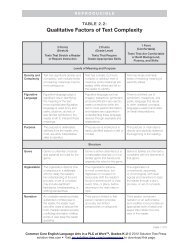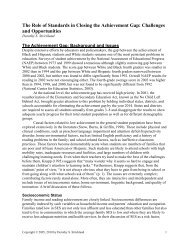Global Education Digest 2012 - International Reading Association
Global Education Digest 2012 - International Reading Association
Global Education Digest 2012 - International Reading Association
You also want an ePaper? Increase the reach of your titles
YUMPU automatically turns print PDFs into web optimized ePapers that Google loves.
OPPORTUNITIES LOST: THE IMPACT OF GRADE REPETITION AND EARLY SCHOOL LEAVING<br />
Economic data<br />
Data on economic indicators such as gross domestic product (GDP) and purchasing power parity (PPP) are<br />
based on the World Bank’s World Development Indicators database of April <strong>2012</strong>. For a small group of countries<br />
where World Bank estimates are not available, data are obtained from the United Nations Statistics Division<br />
(UNSD).<br />
Economic-based indicators are listed as missing (…) when economic data are not available or not considered<br />
reliable.<br />
TECHNICAL NOTES<br />
<strong>Education</strong> data and indicators<br />
Regional averages are based on publishable data, as well as imputed values for missing or unpublishable data<br />
for each country within a given region.<br />
Where the publishable data represent between 33% and 60% of the relevant population, the regional average is<br />
marked with the symbol **.<br />
Where the publishable data represent less than 33% of the regional population, the average is not published.<br />
Where the publishable data represent 60% or more of the original population, the average is considered as<br />
observed.<br />
Where data inconsistencies result in an indicator exceeding its theoretical maximum (e.g. 100% in the case of<br />
the net enrolment rate), it is “capped” in such a way as to maintain the same ratio between male and female<br />
values (see Annex A).<br />
Due to rounding, gender parity indices (GPI) may differ from those based directly on the published values of<br />
indicators. Similarly, totals may not always be the sum of their component parts.<br />
The percentage of females (% F) is included to provide information on the proportion of women in a given<br />
population (e.g. enrolment, graduates or teachers). For assessing gender parity, a more relevant measure is the<br />
GPI.<br />
<strong>Education</strong> finance<br />
Expenditure on pre-primary education or from international sources – both of which are often comparatively<br />
small – have been treated as negligible in cases where data were in fact missing. In these cases, total education<br />
expenditure may be underestimated.<br />
<strong>Education</strong>al attainment<br />
Data on educational attainment are presented by ISCED level. In addition to the categories related to completed<br />
education levels, three other columns are presented in Table 15:<br />
••<br />
“No schooling” refers to the percentage of the population without any formal schooling;<br />
••<br />
“Incomplete primary” refers to the percentage of the population that has attended primary education but not<br />
completed the level; and<br />
••<br />
“Unknown” refers to the percentage of the population for which the educational level could not be<br />
determined.<br />
79

















